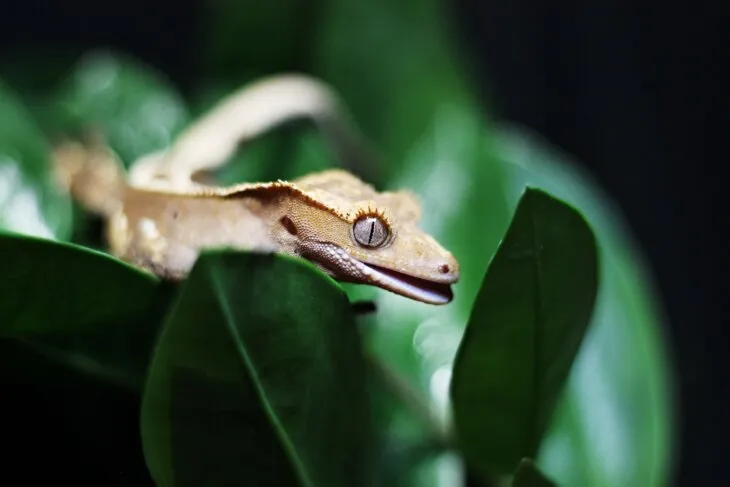
Crested geckos naturally sleep curled up among the branches and leaves in their immediate environment. However, some crested geckos in captivity spend a lot of time hanging upside down on the walls of their terrarium.
The lack of climbing options inside the enclosure can cause a crested gecko to hang upside down on the walls. Remaining in this position for considerable lengths of time can lead to Floppy Tail Syndrome and other issues.
If you’d like to know more about this strange behavior of crested geckos and how to prevent your pet from doing it, read on!
Table of Contents
Why Is A Crested Gecko Hanging Upside Down?
Crested geckos are nocturnal and crepuscular. This means that they sleep during the day and are most active during dusk and dawn.
Crested geckos are arboreal, thus their immediate environment must have enough opportunities to encourage climbing, curling, and jumping.
In the wild, they tend to curl up under leaves and beneath barks of trees. These spots can help protect them from natural predators.
In captivity, crested geckos retain their natural instinctive behaviors and are often curled up among the branches and leaves in their enclosure.
Sometimes, a crested gecko sleeps upside down on the wall of its terrarium. This behavior can be attributed to the lack of climbing and sleeping surfaces that are available for the crested gecko. Unfortunately, this habit can have negative consequences.
What Can Happen When Your Crested Gecko Keeps On Hanging Upside Down?
Crested geckos that spend most of their time hanging upside down on the walls of their terrarium have higher risks of developing Floppy Tail Syndrome.
Hanging upside down causes a crested gecko’s tail to hang down over its head for prolonged periods of time. This can make the muscles of the tail weak and eventually floppy.
As they hang down towards the ground, gravity pulls their hips downward and causes undue stress on the gecko’s pelvis. This can eventually weaken the pelvis and cause the hip bones to become deformed, giving the gecko a crooked appearance.
The deformed hip can affect the egg-laying ability of female geckos and also make walking or climbing painful for the crested gecko.
Note: We created an entire article on Floppy Tail Syndrome in crested geckos and how to prevent it here.

Tips To Prevent Your Crested Gecko From Hanging Upside Down
If you noticed your crested gecko hanging upside down, you should fix the problem by making changes to your pet’s enclosure.
Plants and Branches
Place more foliage and horizontal branches inside the terrarium where your gecko can climb and curl up during the day. Make sure they’re sturdy enough not to break or bend.
Live plants that are placed inside the terrarium should be safe if ingested and allow crested geckos to engage in natural behaviors.
Some of the most popular live plants for crested gecko enclosures include the following:
- Ficus or weeping fig
- Pothos
- Bird’s nest fern
- Moss
- Dracaena
- Sansevieria
- Bromeliads
Fake plants can also be used inside your crested gecko’s enclosure. Just make sure that they’re safe and sturdy enough to support your pet.
Plants provide plenty of spaces to explore and hide in while keeping the humidity inside the terrarium stable even at higher levels. Plants keep them feel safe and secure. They’re also aesthetically pleasing.
A few branches in the terrarium (vivarium) will give it a natural look and give your crested gecko more opportunities to climb and exercise. Choose thick, wooden branches that are rot-resistant.
Tip: Have a look at our article on the best plants for a crested gecko tank here!
Terrarium Accessories
Gecko-friendly terrarium accessories can give your pet something to climb, hide, and sleep in.
Some of the most popular accessories for your gecko’s
Vertical Spaces
Creating more vertical spaces gives your crested gecko more activity space for exercise, climbing, and sleeping. With less wall space, your crested gecko has lesser opportunities to sleep upside down.
Various textures
To create further enrichment and stimulation for your gecko, use different types of bark, woods, vines, sticks, etc. so there will be various textures to climb on. This can also help them during shedding.
When enriching the immediate environment of a crested gecko, plants, branches, and cage accessories should only occupy about half of your crested gecko’s terrarium so there will be enough space for your pet to move around.
- Enchi Ball Python: A Unique and Stunning Morph of Python regius - March 27, 2025
- Emerald Tree Monitor: The Enigmatic Green Guardian of the Rainforest - March 26, 2025
- The Egyptian Cobra (Naja haje): A Fascinating Serpent - March 25, 2025
